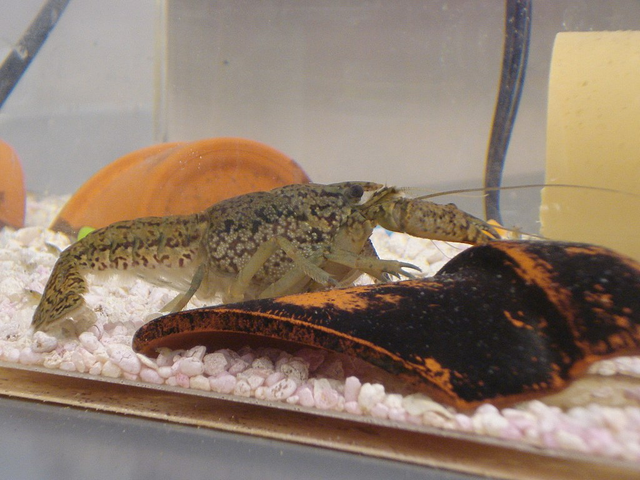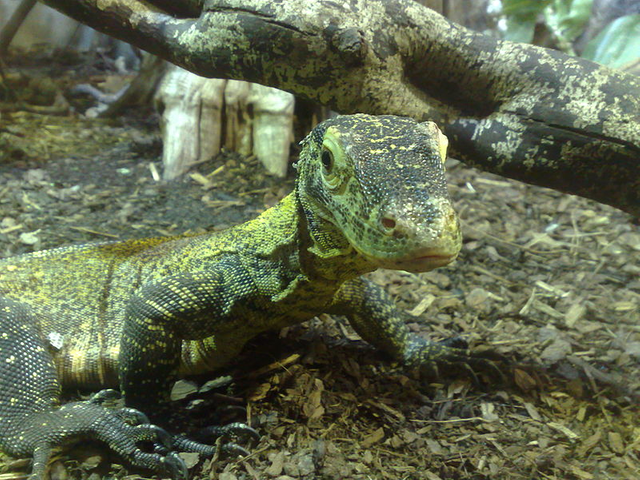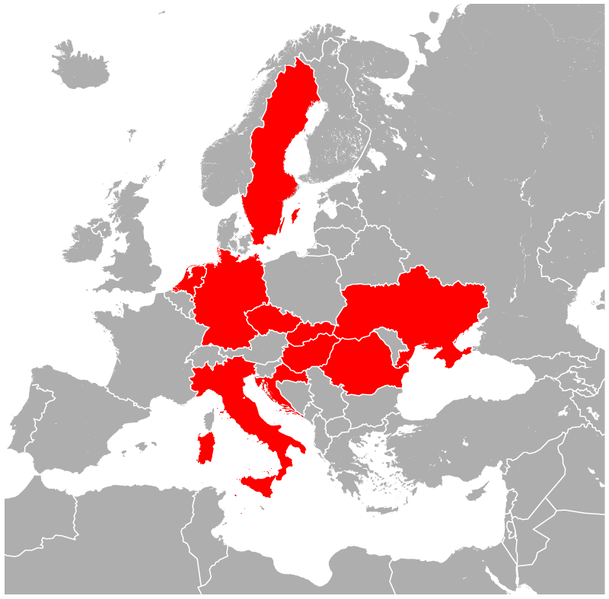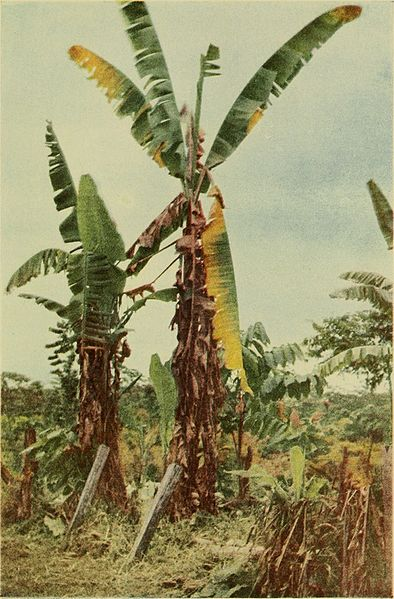Attack of The Clones: Animal Parthenogenesis
The marbled crayfish, or marmorkreb, didn't exist as a species 25 years ago. Today, they number in the countless millions, and are seriously threatening ecosystems in Europe and Madagascar.

The marbled crayfish. [Image source]
25 years seems an astonishing time for a whole new species to appear, but it all occurred thanks to a single mutation. A slough crayfish, a native of Florida and Georgia, apparently developed a mutation while being shipped to Germany. It gained the ability to reproduce without sex- it cloned itself. Marbled crayfish are universally female, all genetically identical, and each is born with the ability to reproduce itself over and over again. It only takes a single marbled crayfish to start a new invasive population, and they've spread to Europe, Madagaskar, and Japan, largely through being released from home aquariums.
Marbled crayfish aren't unique in the animal kingdom for their ability to clone themselves. This process is known as parthenogenesis, and is found in a few other plants and animals. It's known in invertebrates, fish, amphibians, reptiles, and even birds (including domesticated chickens and turkeys!). For hopefully obvious reasons, parthenogenesis always occurs among females. It's somewhat unusual to have an entirely parthenogenic species, however- it's usually just a last ditch strategy if there aren't any available males for mating. Other entirely parthenogenic species include a type of velvet worm and a couple species of goblin spiders.

A parthenogenetic Komodo Dragon hatchling. Komodo dragons can reproduce either sexually or parthenogenetically. [Image source]
The marbled crayfish is an incredible success story as an invasive species, and they raise a lot of interesting questions. First off, why doesn't every species reproduce this way? It clearly is quite effective. It also, however, leaves the species quite vulnerable in some ways. Most notably, any species that is entirely composed of clones is far more vulnerable to disease. Any disease deadly to one is deadly to all. When a species is more genetically diverse, it's more likely to have members that are resistant or even immune to a disease. A single nasty pathogen could wipe out the entire species.
Next, why don't we see more of these species alive today or in the fossil record? Well, it's likely that clonal species are particularly short lived. The disease vulnerability is an obvious reason why, but there's another more subtle one- since all the members of the species are genetically identical, evolution is inhibited in the population. Without sex to mix up genetics, the species can't effectively respond to changing circumstances in their environments like a non clonal species. To confuse things even more, many species are morphologically identical to the degree that clones are but are extremely genetically diverse- so it's nearly impossible to tell if a fossil species is cloned, even if we find significant numbers of examples of them, which is highly unlikely among a clonal species with a probable species lifespan measured in tens of thousands of years or less.

The European range of the marbled crayfish. They're also present in Madagascar and Japan. [Image source]
Interestingly, thought marbled crayfish are all genetically identical, there is a reasonably large variation in coloring. This is most likely the result of environmental influences. Marbled crayfish raised alone in captivity tend to often be blue rather than grey. Even more interestingly, phenotypal variation in clones is pretty common, even in artificially produced clones. This is because your appearance, or phenotype, isn't exactly determined by your genes- instead, the way those genes are expressed are influenced by the way the environment affects them.
The marbled crayfish, and other clonal species, are a strong part of the argument that speciation- the formation of new species- might be a much more rapid process than previously thought. Speciation occuring over a single generation, like with the marbled crayfish, might be significantly more common than we once expected.
One reason this is all especially important to humans is that many of our important crops are clones. One of the most notable is bananas- which are not only the most widely consumed fruit in America, but are actually a critical staple food source for millions of people around the globe. While there are other varieties of banana, the overwhelming majority are a variety known as Cavendishes, which are all clones of one another. They're facing a potential extinction threat from the same fungus that wiped out the last popular variety of banana, the Gros Michel or Big Mike- which, by all accounts, was much bigger and tastier than the Cavendish. (The slapstick trip on a banana peel gag was actually a real threat in the early 1900s in America, since bananas were even more absurdly popular then.) If the Cavendish goes, people around the wold face economic dissolution and even starvation.

A Big Mike banana plant in 1919 suffering from the wilting disease that killed them all off by the 1950s. [Image source]
Bibliography:
https://www.nytimes.com/2018/02/05/science/mutant-crayfish-clones-europe.html
https://www.nature.com/articles/s41559-018-0467-9
https://en.wikipedia.org/wiki/Marbled_crayfish
http://www.bbc.com/news/world-43032061
https://en.wikipedia.org/wiki/Gros_Michel_banana
https://en.wikipedia.org/wiki/Parthenogenesis
My geology classes
This is a test comment, notify @kryzsec on discord if there are any errors please.
Being A SteemStem Member
You received a 80.0% upvote since you are a member of geopolis.
To read more about us and what we do, click here.
https://steemit.com/geopolis/@geopolis/geopolis-the-community-for-global-sciences-update-3
If you do not want us to upvote and comment on your posts concerning earth and earth sciences, please reply stop to this comment and we will no longer bother you with our love ❤️
I wonder if some clone will ever evolve back into a sexually reproducing species. Either way that rate of growth is incredible.
The problem here isn't the odds against that happening, but the odds of such a mutation then meeting another identical mutation of the opposite sex. The bigger the population, the better the odds.
Fascinating article. Rotifers are another great example of parthenogenesis. Some species can switch between sexual or asexual reproduction. This is believed to optimize colonization via rapid reproduction.
Some species of rotifer are entirely parthenogenetic, showing animals can persist without sex (bad news, I know). And importantly here, parthenogenetic animals can keep evolving. When populations bloom in favourable conditions, enough genetic variation accumulates to respond to change.
Ooh, I need to read more about these guys!
Quite an old paper, but a good place to start if you are interested: Article Link
OMG I was gonna write on this, this week :P
Good post though mate looks like you've covered it well!
Such an interesting take on how to stay alive and a neat little evolutionary trick. Love it :)
I've definitely had people scoop a topic from me before too! I'm glad you like it, though!
Haha, life of the steemit poster :)
That brought back a memory of Jurassic Park actually. Cloned dinosaurs would have very little immunity to modern bacteria and viruses.
The fact that a single mutation can cause such drastic change in a species is amazing. Genetics always fascinated me.
the arthenogenetic Komodo Dragon look soo cute but deadly at the same time haha.
Your Post Has Been Featured on @Resteemable!
Feature any Steemit post using resteemit.com!
How It Works:
1. Take Any Steemit URL
2. Erase
https://3. Type
reGet Featured Instantly � Featured Posts are voted every 2.4hrs
Join the Curation Team Here | Vote Resteemable for Witness
@moutainwashere thanks for positing this article. You may also be interested in a new paper from Nature Ecology and Evolution. The asexual vertebrate called the Amazon molly fish, Poecilia Formosa.
These organisms show that you can do well without sex lol.
Happy Valentine's Day!